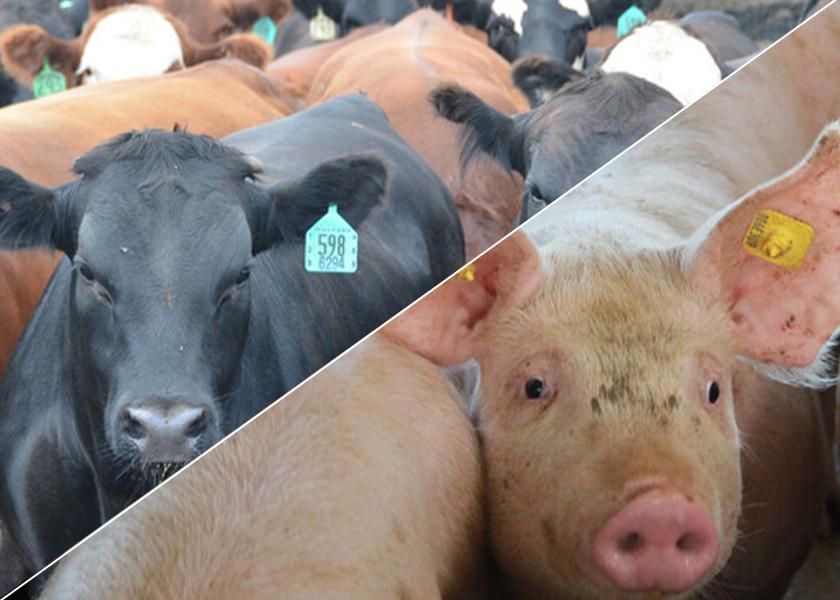Livestock Analysis | November 3, 2022

Price action: December hogs rose 7.5 cents to $83.375, after falling earlier to the lowest intraday level since Oct. 17.
Fundamental analysis: Nearby lean hogs erased early declines and posted modest corrective gains, though prices closed near today’s lows and cash fundamentals continued to soften. The CME lean hog index fell 46 cents to a two-week low of $93.29, the fifth drop in the past six days. Friday’s index is expected to drop another 95 cents to $92.34, nearly $9.00 above December futures, compared to $5.545 two weeks ago. Pork cutout values jumped $1.56 early to $97.79, still near a nine-month low. Cash weakness could soon dissipate, as domestic hog and turkey production are below year-ago levels and frozen stockpiles of both are well below normal, suggesting support from ham and turkey markets into mid-December.
Early today, USDA reported net weekly U.S. pork sales at 47,900 MT, more than double the previous week’s 20,300 MT and a 40-week high. Top buyers included Mexico (12,700 MT, including decreases of 400 MT), China (11,200 MT, including decreases of 400 MT) and Japan (9,300 MT, including decreases of 200 MT). Accumulated pork shipments so far this year are trailing last year by nearly 25% but remain historically steady at 1.421 MMT as of Oct. 27, which is the fourth largest figure for the time period.
Technical analysis: December hogs traded a $1.55 cent range, testing first support at $82.75 and making a session low at second support around $82.20. Support will continue here, as a close was held above both levels. Further support will stand at $81.15. Resistance levels remained untested in today’s session and will continue to stand at $84.35, $85.40, and $85.95 in upside attempts.
What to do: Get current with advised soymeal coverage. Be prepared to extend coverage on additional price pressure.
Hedgers: Carry all risk in the cash market for now.
Feed needs: You have 100% of soybean meal needs through mid-November covered in the cash market. You are hand-to-mouth on corn-for-feed needs.
Price action: December live cattle futures rose 55 cents to $151.95, while deferred contracts declined. January feeder cattle dropped 57.5 cents to $179.425.
Fundamental analysis: December live cattle futures rose for the first time in six sessions as cash trading picked up, with the Monday-Wednesday average gaining $151.79, a $1.30 rise from the week-prior figure. However, the figure was down from last week’s average of $151.95. Cash trade during the first half of the week reflects a seeming return to the bifurcation of the cattle market seen last summer, with Nebraska and Iowa markets up $1.00 to $2.00 over week-ago levels and averaging around $153.00. By contrast, significant numbers of steers in Texas-Oklahoma and Kansas markets were trading around $149.00, which may reflect a Plains weather front last week that brought snow and cold to northern areas but spared southern parts.
Dry, warm weather across the Plains recently appears to have accelerated feedlot performance, muting the impact of a shortage of market-ready animals and limiting price upside in live cattle futures. We expect wintry weather to eventually affect feedlots and possibly power prices higher, but more plentiful southern supplies may continue limiting gains in the short run. Still, wholesale prices continue edging upward, with Choice beef cutout values up $1.51 to $264.98 early today and the Choice-Select spread remaining extremely wide at $31.29.
After rallying strongly in response to diving grain and soy prices Wednesday, feeder cattle futures were unable to build on those gains as grain markets traded mixed-to-lower.
Technical analysis: Bulls still own a short-term technical advantage in December live cattle, especially after bears proved unable to mount a serious challenge of initial support at the contract’s 20-day moving average near $152.76. Look for major support at the confluence of the psychological $150.00 level and the 40-day moving average near $149.99. A drop below that point would have bears targeting the early-October low at $147.775, then the $145.00 level. Resistance at today’s high of $152.225 is solidly backed by the 10-day moving average near $152.76. A close above that point would have bulls targeting the contract high at $154.25 and beyond.
January feeder futures are neutral. Bears were able to force a close back below the pivotal 40-day moving average (and now initial resistance) near $179.65. That’s closely backed by the 10-day moving average at $180.16 and yesterday’s high at $180.725. A push above that level would have bulls targeting the October high at $182.375, then the psychological $185.00 level. Support at today’s low of $179.00 is reinforced by the 20-day moving average near $178.67, then by Monday’s low at $177.70. A drop below that point would open the door to a test of the $175.00 level.
What to do: Get current with advised soymeal coverage. Be prepared to extend coverage on additional price pressure.
Hedgers: Carry all risk in the cash market for now.
Feed needs: You have 100% of soybean meal needs through mid-November covered in the cash market. You are hand-to-mouth on corn-for-feed needs.






